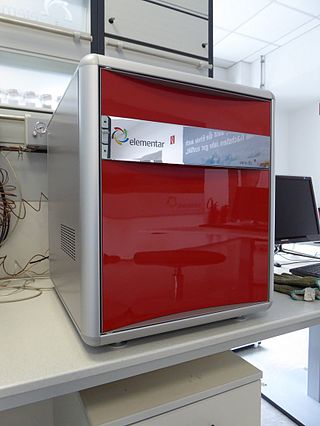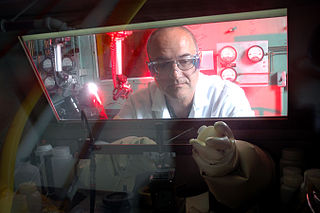Related Research Articles

The neutron is a subatomic particle, symbol
n
or
n0
, that has no electric charge, and a mass slightly greater than that of a proton. Protons and neutrons constitute the nuclei of atoms. Since protons and neutrons behave similarly within the nucleus, they are both referred to as nucleons. Nucleons have a mass of approximately one atomic mass unit, or dalton. Their properties and interactions are described by nuclear physics. Protons and neutrons are not elementary particles; each is composed of three quarks.

Spectroscopy is the field of study that measures and interprets electromagnetic spectra. In narrower contexts, spectroscopy is the precise study of color as generalized from visible light to all bands of the electromagnetic spectrum.
Fourier-transform spectroscopy (FTS) is a measurement technique whereby spectra are collected based on measurements of the coherence of a radiative source, using time-domain or space-domain measurements of the radiation, electromagnetic or not. It can be applied to a variety of types of spectroscopy including optical spectroscopy, infrared spectroscopy, nuclear magnetic resonance (NMR) and magnetic resonance spectroscopic imaging (MRSI), mass spectrometry and electron spin resonance spectroscopy.

Radioactive decay is the process by which an unstable atomic nucleus loses energy by radiation. A material containing unstable nuclei is considered radioactive. Three of the most common types of decay are alpha, beta, and gamma decay. The weak force is the mechanism that is responsible for beta decay, while the other two are governed by the electromagnetic and nuclear forces.
Particle-Induced X-Ray Emission or Proton-Induced X-Ray Emission (PIXE) is a technique used for determining the elemental composition of a material or a sample. When a material is exposed to an ion beam, atomic interactions occur that give off EM radiation of wavelengths in the x-ray part of the electromagnetic spectrum specific to an element. PIXE is a powerful, yet non-destructive elemental analysis technique now used routinely by geologists, archaeologists, art conservators and others to help answer questions of provenance, dating and authenticity.

The emission spectrum of a chemical element or chemical compound is the spectrum of frequencies of electromagnetic radiation emitted due to electrons making a transition from a high energy state to a lower energy state. The photon energy of the emitted photons is equal to the energy difference between the two states. There are many possible electron transitions for each atom, and each transition has a specific energy difference. This collection of different transitions, leading to different radiated wavelengths, make up an emission spectrum. Each element's emission spectrum is unique. Therefore, spectroscopy can be used to identify elements in matter of unknown composition. Similarly, the emission spectra of molecules can be used in chemical analysis of substances.

A synchrotron light source is a source of electromagnetic radiation (EM) usually produced by a storage ring, for scientific and technical purposes. First observed in synchrotrons, synchrotron light is now produced by storage rings and other specialized particle accelerators, typically accelerating electrons. Once the high-energy electron beam has been generated, it is directed into auxiliary components such as bending magnets and insertion devices in storage rings and free electron lasers. These supply the strong magnetic fields perpendicular to the beam that are needed to stimulate the high energy electrons to emit photons.
A semiconductor detector in ionizing radiation detection physics is a device that uses a semiconductor to measure the effect of incident charged particles or photons.

Elemental analysis is a process where a sample of some material is analyzed for its elemental and sometimes isotopic composition. Elemental analysis can be qualitative, and it can be quantitative. Elemental analysis falls within the ambit of analytical chemistry, the instruments involved in deciphering the chemical nature of our world.

Neutron activation is the process in which neutron radiation induces radioactivity in materials, and occurs when atomic nuclei capture free neutrons, becoming heavier and entering excited states. The excited nucleus decays immediately by emitting gamma rays, or particles such as beta particles, alpha particles, fission products, and neutrons. Thus, the process of neutron capture, even after any intermediate decay, often results in the formation of an unstable activation product. Such radioactive nuclei can exhibit half-lives ranging from small fractions of a second to many years.

Neutron capture is a nuclear reaction in which an atomic nucleus and one or more neutrons collide and merge to form a heavier nucleus. Since neutrons have no electric charge, they can enter a nucleus more easily than positively charged protons, which are repelled electrostatically.

Radiochemistry is the chemistry of radioactive materials, where radioactive isotopes of elements are used to study the properties and chemical reactions of non-radioactive isotopes. Much of radiochemistry deals with the use of radioactivity to study ordinary chemical reactions. This is very different from radiation chemistry where the radiation levels are kept too low to influence the chemistry.
Nuclear reaction analysis (NRA) is a nuclear method of nuclear spectroscopy in materials science to obtain concentration vs. depth distributions for certain target chemical elements in a solid thin film.
Ion beam analysis (IBA) is an important family of modern analytical techniques involving the use of MeV ion beams to probe the composition and obtain elemental depth profiles in the near-surface layer of solids. IBA is not restricted to MeV energy ranges. It can be operated at low energy (<Kev) using techniques such as FIB, and Secondary ion mass spectroscopy, as well as at higher energies (>GeV) using instruments like the LHC. All IBA methods are highly sensitive and allow the detection of elements in the sub-monolayer range. The depth resolution is typically in the range of a few nanometers to a few ten nanometers. Atomic depth resolution can be achieved, but requires special equipment. The analyzed depth ranges from a few ten nanometers to a few ten micrometers. IBA methods are always quantitative with an accuracy of a few percent. Channeling allows to determine the depth profile of damage in single crystals.
Radiation chemistry is a subdivision of nuclear chemistry which studies the chemical effects of ionizing radiation on matter. This is quite different from radiochemistry, as no radioactivity needs to be present in the material which is being chemically changed by the radiation. An example is the conversion of water into hydrogen gas and hydrogen peroxide.

Muon capture is the capture of a negative muon by a proton, usually resulting in production of a neutron and a neutrino, and sometimes a gamma photon.

Mössbauer spectroscopy is a spectroscopic technique based on the Mössbauer effect. This effect, discovered by Rudolf Mössbauer in 1958, consists of the nearly recoil-free emission and absorption of nuclear gamma rays in solids. The consequent nuclear spectroscopy method is exquisitely sensitive to small changes in the chemical environment of certain nuclei.

A gamma ray, also known as gamma radiation (symbol
γ
), is a penetrating form of electromagnetic radiation arising from the radioactive decay of atomic nuclei. It consists of the shortest wavelength electromagnetic waves, typically shorter than those of X-rays. With frequencies above 30 exahertz (3×1019 Hz) and wavelengths less than 10 picometers (1×10−11 m), gamma ray photons have the highest photon energy of any form of electromagnetic radiation. Paul Villard, a French chemist and physicist, discovered gamma radiation in 1900 while studying radiation emitted by radium. In 1903, Ernest Rutherford named this radiation gamma rays based on their relatively strong penetration of matter; in 1900, he had already named two less penetrating types of decay radiation (discovered by Henri Becquerel) alpha rays and beta rays in ascending order of penetrating power.

The Philippine Nuclear Research Institute (PNRI) is a government agency under the Department of Science and Technology mandated to undertake research and development activities in the peaceful uses of nuclear energy, institute regulations on the said uses, and carry out the enforcement of said regulations to protect the health and safety of radiation workers and the general public.
References
- ↑ "IBANDL". www-nds.iaea.org. Retrieved 2023-04-01.
- ↑ Dimitriou, P.; Becker, H.-W.; Bogdanović-Radović, I.; Chiari, M.; Goncharov, A.; Jesus, A.P.; Kakuee, O.; Kiss, A.Z.; Lagoyannis, A.; Räisänen, J.; Strivay, D.; Zucchiatti, A. (2016). "Development of a Reference Database for Particle-Induced Gamma-ray Emission spectroscopy". Nuclear Instruments and Methods in Physics Research Section B: Beam Interactions with Materials and Atoms. 371: 33–36. Bibcode:2016NIMPB.371...33D. doi:10.1016/j.nimb.2015.09.052. hdl: 2268/200104 .
- ↑ Ritter, Evelyn E.; Dickinson, Margaret E.; Harron, John P.; Lunderberg, David M.; DeYoung, Paul A.; Robel, Alix E.; Field, Jennifer A.; Peaslee, Graham F. (September 2017). "PIGE as a screening tool for Per- and polyfluorinated substances in papers and textiles". Nuclear Instruments and Methods in Physics Research Section B: Beam Interactions with Materials and Atoms. 407: 47–54. Bibcode:2017NIMPB.407...47R. doi: 10.1016/j.nimb.2017.05.052 .
- ↑ Tighe, Meghanne; Jin, Yukun; Whitehead, Heather D.; Hayes, Kathleen; Lieberman, Marya; Pannu, Meeta; Plumlee, Megan H.; Peaslee, Graham F. (2021-12-10). "Screening for Per- and Polyfluoroalkyl Substances in Water with Particle Induced Gamma-Ray Emission Spectroscopy". ACS ES&T Water. 1 (12): 2477–2484. doi:10.1021/acsestwater.1c00215. S2CID 244412099.
- ↑ Tokranov, Andrea K.; Nishizawa, Nicole; Amadei, Carlo Alberto; Zenobio, Jenny E.; Pickard, Heidi M.; Allen, Joseph G.; Vecitis, Chad D.; Sunderland, Elsie M. (2019-01-08). "How Do We Measure Poly- and Perfluoroalkyl Substances (PFASs) at the Surface of Consumer Products?". Environmental Science & Technology Letters. 6 (1): 38–43. Bibcode:2019EnSTL...6...38T. doi:10.1021/acs.estlett.8b00600. PMC 7713715 . PMID 33283017.